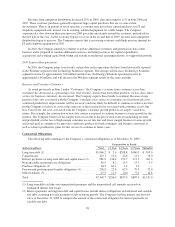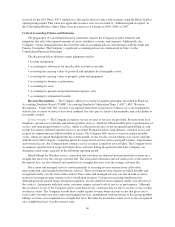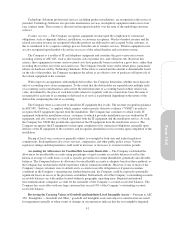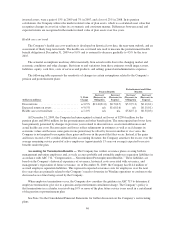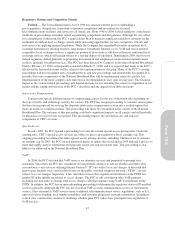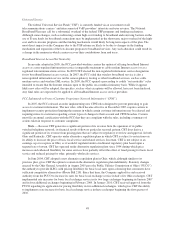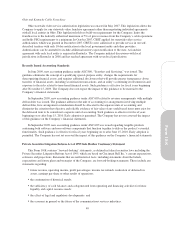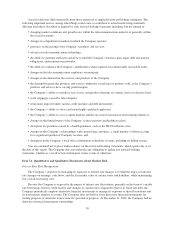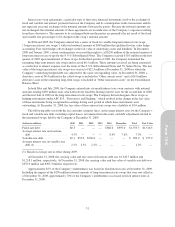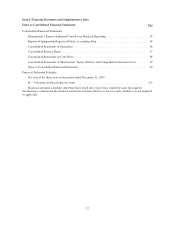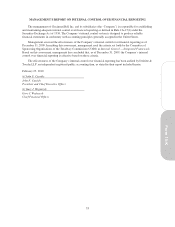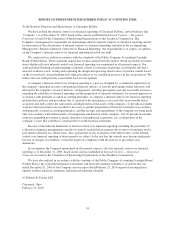Cincinnati Bell 2009 Annual Report Download - page 115
Download and view the complete annual report
Please find page 115 of the 2009 Cincinnati Bell annual report below. You can navigate through the pages in the report by either clicking on the pages listed below, or by using the keyword search tool below to find specific information within the annual report.
The Company incurred special termination benefit charges of $8.2 million in the fourth quarter of 2007 due
to 105 management employees accepting early retirement special termination benefits. In the first quarter of
2008, the Company incurred an additional $22.1 million related to 284 union employees accepting early
retirement special termination benefits. The Company also recorded $2.1 million and $4.9 million of expense
during 2009 and 2008, respectively, related to remaining special termination benefits being amortized over the
future service period for both the management and union employees. As a result of the early retirement special
termination benefits which decreased the expected future service years of the plan participants, the Company
determined curtailment charges were required. The 2008 curtailment charge for the union pension plan and union
postretirement plan consisted of an increase in the benefit obligation of $2.2 million and $12.5 million, and the
acceleration of unrecognized prior service cost of $0.9 million and a benefit of $0.1 million, respectively. In
2007, the curtailment charge for the management pension plan and management postretirement plan consisted of
an increase in the benefit obligation of $1.9 million and $4.3 million, and the acceleration of an unrecognized
prior service cost and transition obligation of a benefit of $1.0 million and a cost of $1.2 million, respectively. In
the first quarter of 2008 as a result of the early retirement special termination benefits, the Company remeasured
its non-management pension and postretirement obligations using revised assumptions, including modified
retiree benefit payment assumptions and a discount rate of 6.4%. As a result of the remeasurement, the
Company’s pension and postretirement obligations were reduced by approximately $17 million, deferred tax
assets were reduced for the related tax effect by $6 million, and equity was increased by $11 million.
In 2007, the Company announced changes to its pension and postretirement plans that reduce medical
benefit payments by fixing the annual Company contribution for certain eligible retirees and that reduce life
insurance benefits paid from these plans. Based on these changes, the Company determined that a remeasurement
of its pension and postretirement obligations was necessary. The Company remeasured its pension and
postretirement obligations in 2007 using revised assumptions, including modified benefit payment assumptions
reflecting the changes and a discount rate of 6.25%. These changes reduced the Company’s pension and
postretirement obligations by approximately $74 million, reduced deferred tax assets for the related tax effect by
$27 million, and increased equity by $47 million.
The key assumptions used to account for the plans are disclosed in Note 9 to the Consolidated Financial
Statements. The actuarial assumptions attempt to anticipate future events and are used in calculating the expenses
and liabilities related to these plans. The most significant of these numerous assumptions, which are reviewed
annually, include the discount rate, expected long-term rate of return on plan assets and health care cost trend
rates.
Discount rate
A discount rate is used to measure the present value of the benefit obligations. The Company determines the
discount rate for each plan individually. In determining the selection of a discount rate, the Company estimates
the timing and expected future benefit payment, and applies a yield curve developed to reflect yields available on
high-quality bonds. Based on the analysis, the discount rate was set at 5.50% for the pension plans and 5.10% for
the postretirement plans as of December 31, 2009 and 6.25% for the pension and postretirement plans as of
December 31, 2008.
Expected rate of return
The expected long-term rate of return on plan assets, developed using the building block approach, is based
on the mix of investments held directly by the plans, which is generally 60% equities and 40% fixed income
securities, and the current view of expected future returns, which is influenced by historical averages. The
required use of an expected versus actual long-term rate of return on plan assets may result in recognized pension
expense or income that is greater or less than the actual returns of those plan assets in any given year. Over time,
however, the expected long-term returns are designed to approximate the actual long-term returns. The Company
used an assumed long-term rate of return of 8.25% on the Company’s pension and postretirement assets to
determine pension and postretirement benefit costs in 2009. At December 31, 2009, the pension asset returns
remained at 8.25%, but the Company decreased the asset returns for the postretirement assets to 0% because
these assets were invested in low-risk securities with low returns given the expected use of these postretirement
plan assets for benefit payments in 2010. Actual asset returns for the pension trusts, which represent over 90% of
45
Form 10-K





